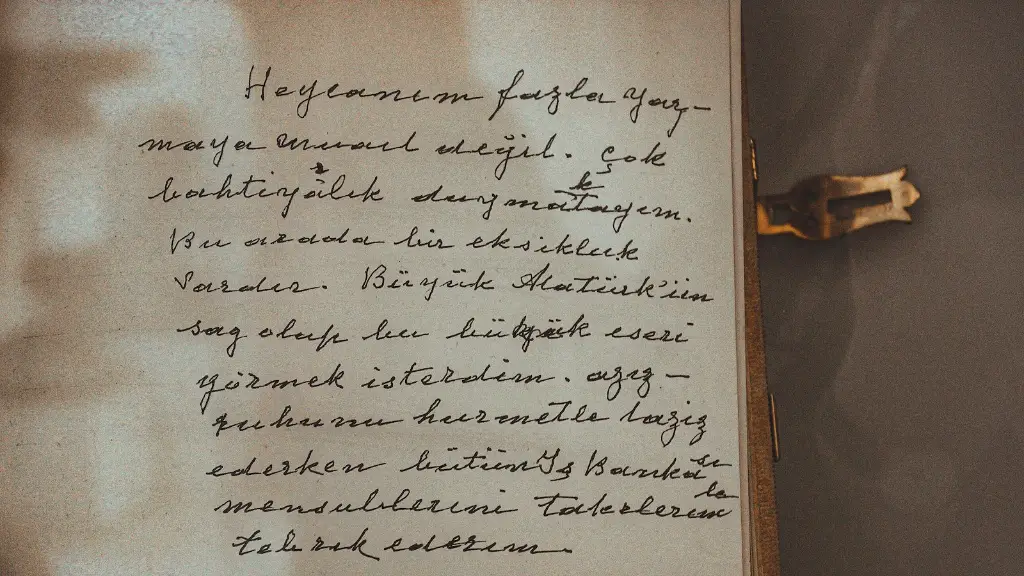A iamb is a two-syllable poetic foot in which the first syllable is unstressed and the second is stressed. Iambic poems have been used by poets throughout the centuries and its rhythmic quality makes it a favorite of many writers. Iambic poetry is often characterized by repetition, as the repeated pulsing of the unstressed syllables creates a consistent meter. In addition, the careful construction of the poem’s form allows for a greater level of symbolism and symbolism-building. This type of poetry was famously used by Shakespeare in his sonnets, where he achieved a heightened effect with the use of a strict iambic structure.
Iambic poems have an elevated elegance and beauty, as the rhythm of the poem feels almost like a song or a lullaby. This makes them an excellent choice for expressing one’s feelings and emotions. Iambic is also a great way to emphasize a certain point, as the consistent rhythm of the poem can draw attention to certain ideas or words. For example, a poet might choose to use iambic meter when writing about a solemn and moving scene, as it helps to convey the feeling of the scene without having to explicitly state it.
Iambic poetic structure often has strong connotations connected to it. It is believed that by utilizing an iamb within a poem, a poet can backhand a message. This is because the inherent rhythm of the iamb can bring out a deeper more profound meaning within each line. In addition, the rhythm of the iambs creates an interplay between the lines of the poem and the sound of the words. This interplay creates a special sense of magic in the poem, and heightens the overall message of the piece.
Iambic poetry also has many specific features and guidelines. For instance, most iambs are written in a pentameter, meaning each line has five metrical feet to create a strong rhythm. The pentameter allows for a sense of consistency to be present through the poem, as each line will match the one before it. Each foot must contain one stressed syllable and one unstressed syllable, in order to maintain the classic iambic meter. With the presence of these specific requirements and guidelines, iambic poetry allows the poet to convey their ideas in a structured and controlled way.
Although iambic poetry does offer a degree of structural control, it’s important to remember that the poet also has to be mindful of the surrounding context and meaning of each line. The poet should try to create a fluid and nuanced poem that reflects the depth of their ideas, and the placement and significance of each word must be taken into consideration. With the correct balance between structure and emotion, iambic poetry can be one of the most mysterious and beautiful forms of writing.
Brief History
Throughout history, iambic poetry has gone by many names, including the iambic pentameter, the heroic couplet, and the Spenserian stanza. The term “iambic” stems from the Greek word “iambos,” which translates to “set of two meters.” Ancient Greek lyric poets were the first to use iambic foot in their poetry, and it soon spread throughout the world. It changed dramatically during the Renaissance period when it was used to explore philosophical concepts, as poets of this era saw iambic poetry as an effective way to express complex ideas.
Iambic poetry was popular in Britain during the 18th and 19th centuries. It was noticeably used by Alexander Pope in his celebrated poem, “The Rape of the Lock.” Over the centuries, many other poets have followed in Pope’s footsteps, most notably T.S. Eliot, who wrote his poem “The Love Song of J. Alfred Prufrock” in iambic pentameter. In modern poetry, iambic is still a favorite of many poets, due to its rhythmic qualities and expressive possibilities.
Uses of Iambic
In addition to its use in poetry, iambic is also frequently employed in English prose. Iambic structure is often used in day-to-day language to convey ideas or feelings, and many famous political speeches and declarations have employed the iambic meter for rhetorical impact. By using iambic structure, a speaker can better emphasize the importance of certain words, as the consistency of the iambic meter helps to magnify the gravity of each point.
Iambic is also a popular choice of meter in contemporary music, and is often used as a way to convey a certain mood. Music genres such as rap, hip-hop and spoken word poetry frequently use iambic structure to create a sense of anticipation and suspense. This is beneficial to the lyricist, as the consistent iambic meter builds a strong foundation for the lyrics to be laid upon. The poetic meter can also be used to elevate the rhythm and tone of a song, as the iambic meter allows for a distinct rhythmic pattern to be established.
Examples of Iambic Poetry
One of the most celebrated examples of iambic poetry is William Shakespeare’s Sonnet 55. This poem, which begins “No! Time shall not boast he hath the better of my company,” is filled with Shakespearian finesse and a strong iambic structure. Each line is written in a perfect iambic pentameter, allowing the poem to be read with an even, steady rhythm. By employing the strict pentameter and consistent iambic structure, Shakespeare was able to create a timeless poem, as the poem’s form highlights the emotion, power, and beauty of the words.
Another clear example of iambic poetry is T.S. Eliot’s renowned poem, “The Love Song of J. Alfred Prufrock.” This poem has been widely praised for its lyrical structure and brilliant imagery. Each line is written in a iambic pentameter, with the typical two-syllable pattern of the iamb appearing clearly throughout. Through this structure, Eliot was able to create a poem that is both complex and profound, as each line is written in a strict and consistent poetic meter. As such, this poem speaks of the power of the iambic structure, and how it can be used to create an atmosphere of beauty and poignancy.
Modern Poetry
Modern poets are frequently inspired by a variety of poetic styles, and are often willing to experiment with different forms. Iambic is still a popular choice of poetic meter among contemporary poets, as iambic structure allows for an interesting interplay between the words and metre. This interplay can create an alluring sense of suspense and mystery, as the words echo off of the beat. Examples of modern poets utilizing iambic structure include E.E. Cummings, Lawrence Ferlinghetti, and Sylvia Plath.
The power of the iamb comes from its combination of structure and lyricism. Whether it be spoken on the stage or written on the page, the iambic structure allows for a heightened sense of emotional depth and intrigue. By utilizing this poetic structure, poets can express their ideas and emotions to a greater degree, while also providing a breath-taking form that dazzles the reader. Any poet – whether beginner or master – can use the iamb as a gateway to convey their message in a poetic, profound and beautiful way.
Symbolism
The power of iambic structure often lies within the symbolism provided by its metrical structure. Each iambic foot carries the two-beat pattern of unstressed and stressed syllables. This creates a pulsing rhythm, which is often seen as symbolic of the beating of a heart. As such, iambic poetry can provide a powerful portrait of emotion, as the rhythm of the poem reflects the feelings that are being expressed. It also symbolizes a continual passage of time, further serving to highlight the importance of each line of the poem.
Rhyme Scheme
Rhyme schemes are a great way to reinforce a poem’s meaning, and this is particularly true in regards to iambic poetry. A poem’s rhyming words fit into the iambic structure, allowing the poet to maintain the consistency of the poem’s meter. Each line of the poem should be written in the same iambic foot, as this reinforces the poem’s message and creates a sense of unity. The repetition of the rhyme also helps to underline the repetition of the poem’s meter, further emphasizing the power of the poem’s structure.
Conclusion
Iambic poetry is a unique form of writing that allows the poet to express his or her feelings and ideas in a structured yet creative manner. This combination of creative expression and structure is what makes iambic such a powerful tool of communication. The flexibility of the structure allows the poet to craft a message with a strong rhythm but their own lyrics. When combined with a powerful rhyme scheme, the iambic meter can achieve a heightened level of word-play and symbolism. Iambic poetry is still popular today, as poets continue to be inspired by the beauty and symbolism associated with it.




